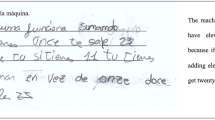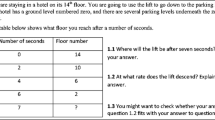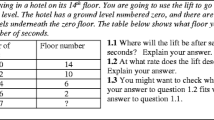Abstract
Based on a synthesis of the relevant literature, this study explored students’ display of behavior in four aspects of the understanding of function: effectiveness in solving a word problem, concept definition, examples of function, recognizing functions in graphic form, and transferring function from one mode of representation to another. A main concern was to examine problem-solving in relation to the other types of displayed behavior. Data were obtained from students in grades 11 and 12. Findings indicated that students were more capable in giving examples of function rather than providing an appropriate definition of the concept. The lowest level of success was observed in problem-solving on functions. Students’ problem-solving effectiveness was found to have a predictive role in whether they would successfully employ the concept in various forms of representation, in giving a definition and examples of function.
Résumé
À partir d’une synthèse de la littérature pertinente, cette étude analyse les comportements des étudiants pour ce qui est de quatre aspects de la compréhension de la fonction: l’efficacité lorsqu’il s’agit de résoudre un problème de mots, la définition des concepts, la présentation d’exemples de fonction, et enfin la reconnaissance des fonctions sous leur forme graphique et leur transposition d’un mode de représentation à l’autre. Nous nous sommes souciés tout particulièrement d’analyser la résolution de problèmes en relation avec les autres types de comportements des étudiants. Les données analysées proviennent d’étudiants de 11e et de 12e années, et les résultats indiquent que les élèves étaient mieux en mesure de fournir des exemples de fonction comparativement à leur capacité de donner une définition juste des concepts. C’est dans la résolution de problèmes regardant les fonctions que le taux de succès a été le moins élevé. Il ressort que l’efficacité des étudiants pour ce qui est de la résolution de problèmes permet de prédire leur capacité d’utiliser avec succès le concept dans ses différentes formes de représentation, et de fournir une définition et des exemples de fonctions.
Similar content being viewed by others
References
Blanton, M., & Kaput, J. (2004). Elementary grades students’ capacity for functional thinking. In M. Johnsen Hoines & A. Berit Fuglestad (Eds.), Proceedings of the 28th Conference of the International Group for the Psychology of Mathematics Education (Vol. 2, pp. 135–142). Bergen, Norway: Bergen University College.
Bodin, A., Coutourier, R., & Gras, R. (2000). CHIC: Classification hiérarchique implicative et cohesive—Version sous Windows—CHIC 1.2. Rennes: Association pour la Recherche en Didactique des Mathématiques.
Demetriou, A. (1998). Cognitive development. In A. Demetriou, W. Doise, & C. F. M. van Lieshout (Eds.), Life-span developmental psychology (pp. 179–270). Chichester: Wiley.
Dubinsky, E., & Harel, G. (1992). The nature of the process conception of function. In E. Dubinsky & G. Harel (Eds.), The concept of function. Aspects of epistemology and pedagogy (pp. 85–106). The Mathematical Association of America. Washington D.C.
Dufour-Janvier, B., Bednarz, N., & Belanger, M. (1987). Pedagogical considerations concerning the problem of representation. In C. Janvier (Ed.), Problems of representation in the teaching and learning of mathematics (pp. 109–122). Hillsdale, NJ: Lawrence Erlbaum.
Duval, R. (2002). The cognitive analysis of problems of comprehension in the learning of mathematics. Mediterranean Journal for Research in Mathematics Education, 1(2), 1–16.
Eisenberg, T. (1992). On the development of a sense for functions. In E. Dubinsky & G. Harel (Eds.), The concept of function. Aspects of epistemology and pedagogy (pp. 153–174). The Mathematical Association of America. Washington D.C.
Eisenberg, T., & Dreyfus, T. (1991). On the reluctance to visualize in mathematics. In W. Zimmermann & S. Cunningham (Eds.), Visualization in teaching and learning mathematics (pp. 9–24). Mathematical Association of America. Washington D.C.
Elia, I., & Spyrou, P. (2006). How students conceive function: A triarchic conceptual-semiotic model of the understanding of a complex concept. The Montana Mathematics Enthousiast, 3(2), 256–272.
Gagatsis, A., & Shiakalli, M. (2004). Ability to translate from one representation of the concept of function to another and mathematical problem solving. Educational Psychology, 24(5), 645–657.
Gras, R. (1992). Data analysis: A method for the processing of didactic questions. Research in didactics of mathematics. Grenoble: La Pensée Sauvage.
Gras, R., Peter, P., Briand, H., & Philippé, J. (1997). Implicative statistical analysis. In C. Hayashi, N. Ohsumi, N. Yajima, Y. Tanaka, H. Bock, & Y. Baba (Eds.), Proceedings of the 5th Conference of the International Federation of Classification Societies (Vol. 2, pp. 412–419). Tokyo: Springer-Verlag.
Greeno, J. G., & Hall, R. P. (1997). Practicing representation: Learning with and about representational forms. Phi Delta Kappan, 78, 361–367.
Hitt, F. (1998). Difficulties in the articulation of different representations linked to the concept of function. The Journal of Mathematical Behavior, 17(1), 123–134.
Kalchman, M., & Case, R. (1998). Teaching mathematical functions in primary and middle school: An approach based on neo-Piagetian theory. Scientia Paedagogica Experimentalis, 35, 7–54.
Kaput, J. (1992). Technology and mathematics education. In D. A. Grouws (Ed.), Handbook of research on mathematics teaching and learning (pp. 515–556). New York: Macmillan.
Lerman, I. C. (1981). Classification et analyse ordinale des données. Paris: Dunod.
Markovits, Z., Eylon, B., & Bruckheimer, M. (1986). Functions today and yesterday. For the Learning of Mathematics, 6(2), 18–28.
Mousoulides, N., & Gagatsis, A. (2004). Algebraic and geometric approach in function problem solving. In M. Johnsen Hoines & A. Berit Fuglestad (Eds.), Proceedings of the 28th Conference of the International Group for the Psychology of Mathematics Education (Vol. 3, pp. 385–392). Bergen, Norway: Bergen University College.
Sfard, A. (1992). Operational origins of mathematical objects and the quandary of reification—The case of function. In E. Dubinsky & G. Harel (Eds.), The concept of function: Aspects of epistemology and pedagogy (pp. 59–84). The Mathematical Association of America. Washington D.C.
Sierpinska, A. (1992). On understanding the notion of function. In E. Dubinsky & G. Harel (Eds.), The concept of function: Aspects of epistemology and pedagogy (pp. 25–28). The Mathematical Association of America. Washington D.C.
Smith, J. P., diSessa, A. A., & Roschelle, J. (1993). Misconceptions reconceived: A constructivist analysis of knowledge in transition. Journal of the learning Sciences, 3, 115–163.
Stylianou, D., & Kaput, J. (2002). Linking phenomena to representations: A gateway to the understanding of complexity. Mediterranean Journal for Research in Mathematics Education, 1(2), 99–111.
Tall, D., & Vinner, S. (1981). Concept images and concept definition in mathematics with particular reference to limits and continuity. Educational Studies in Mathematics, 12, 151–169.
Vinner, S. (1983). Concept definition, concept image and the notionof function. The International Journal of Mathematical Education in Science and Technology, 14, 293–305.
Vinner, S., & Dreyfus, T. (1989). Images and definitions for the concept of function. Journal for Research in Mathematics Education, 20(4), 356–366.
Author information
Authors and Affiliations
Corresponding author
Additional information
This article was accepted by Dr. Gila Hanna.
Rights and permissions
About this article
Cite this article
Elia, I., Panaoura, A., Gagatsis, A. et al. Exploring Different Aspects of the Understanding of Function: Toward a Four-Facet Model. Can J Sci Math Techn 8, 49–69 (2008). https://doi.org/10.1080/14926150802152277
Published:
Issue Date:
DOI: https://doi.org/10.1080/14926150802152277




